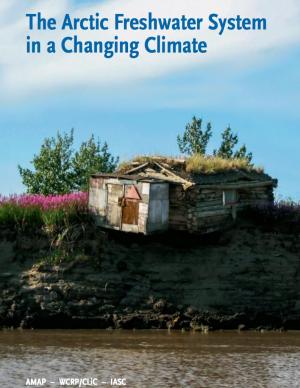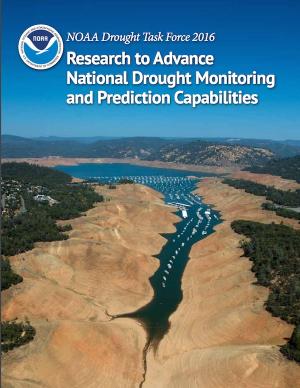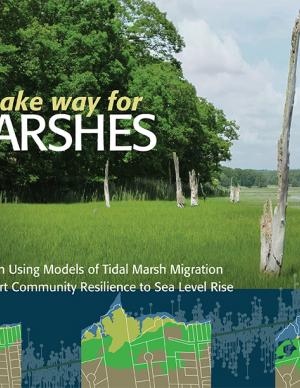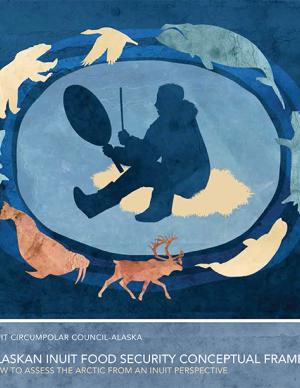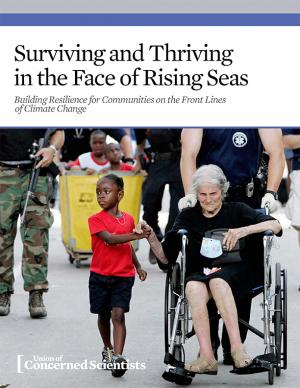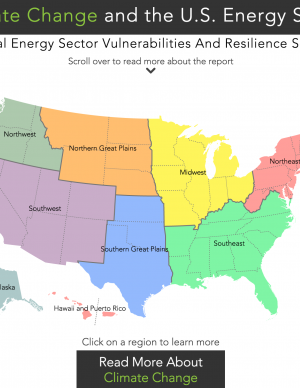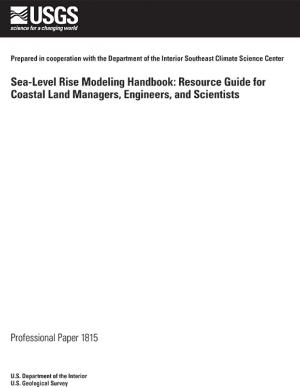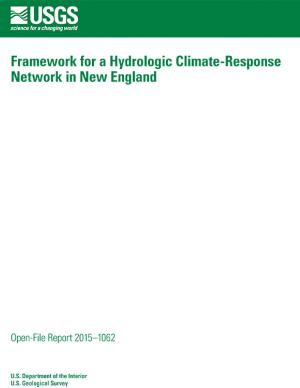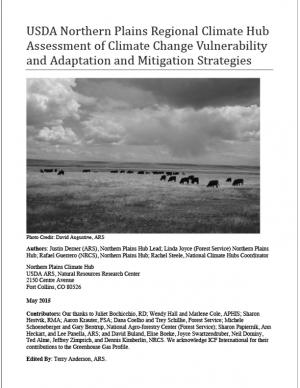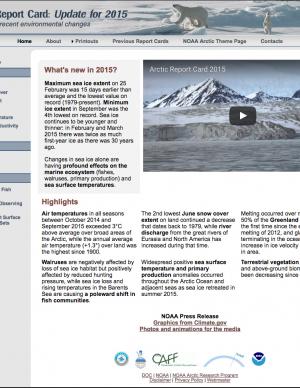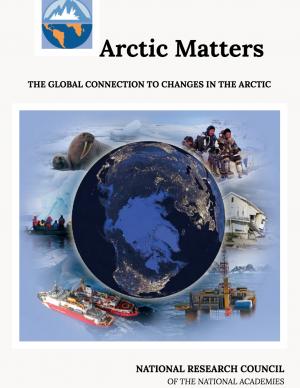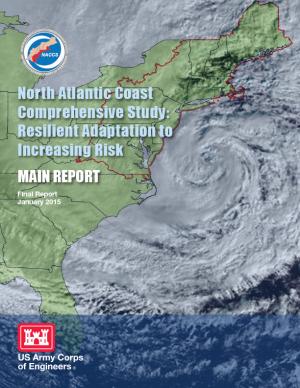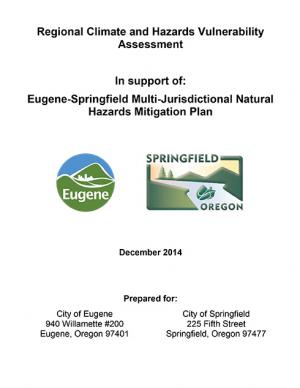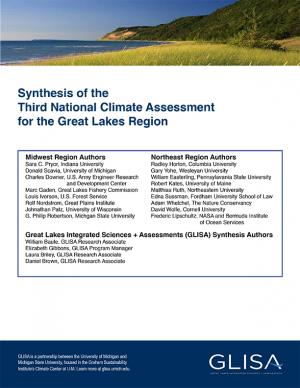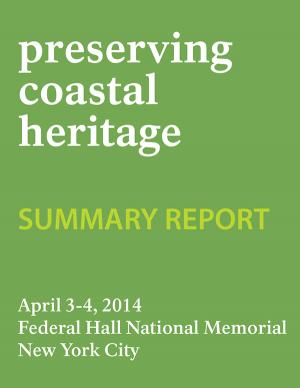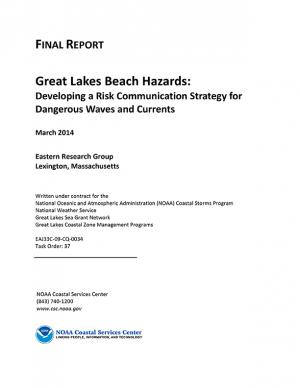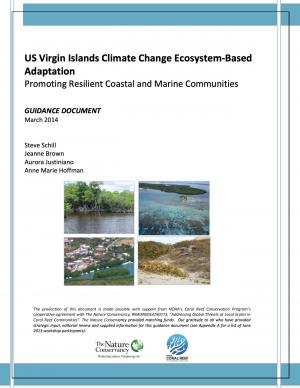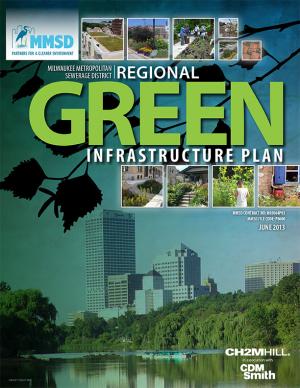Access a range of climate-related reports issued by government agencies and scientific organizations. Browse the reports listed below, or filter by scope, content, or focus in the boxes above. To expand your results, click the Clear Filters link.
This fact sheet presents recent climate change investigations of the U.S. Geological Survey in New England using selected recent publications that highlight the broad spectrum of expertise and commitment to understanding the relations of climate change and water resources in the region.
The Arctic is changing at a startling pace. Understanding the role of freshwater in these changes—both how Arctic freshwater systems are affected by climate change, and how changes to the Arctic freshwater system will affect other environmentally relevant processes—is critical to understanding how these changes will affect the lives of people living in the Arctic and beyond. This report is intended to inform the non-expert reader about these changes to the freshwater systems in the Arctic, and their implications.
The SECURE Water Report identifies climate change as a growing risk to Western water management and cites warmer temperatures, changes to precipitation, snowpack and the timing and quality of streamflow runoff across major river basins as threats to water sustainability. Water supply, quality and operations; hydropower; groundwater resources; flood control; recreation; and fish, wildlife and other ecological resources in the Western states remain at risk.
Drought threatens our country’s natural resources, economy, and overall health. Increasingly, NOAA is charged with providing and improving information that helps stakeholders at all levels manage water resources in a more resilient and climate-smart manner. Working with input from farmers, ranchers, natural resource managers, and other drought-impacted industries and populations, NOAA research has worked to improve drought monitoring and prediction for better planning and mitigation of impacts.
Rapidly rising seas threaten to drown tidal marshes and diminish the benefits provided to people and wildlife by these valuable coastal ecosystems. Increasingly, government agencies and non-government organizations are harnessing the power of computer-based models of marsh ecosystems to inform management and policy strategies to sustain tidal marshes. This report covers the entire modeling lifecycle, from developing a modeling approach and working with data to communicating modeling results. While some of the information pertains specifically to the northeastern United States, the report is also intended as a useful resource for modeling of marsh migration in other regions. The report is available online, with a printer-friendly version also available for download.
This technical report focuses on sharing the collective efforts of the Inuit Circumpolar Council-Alaska, 146 Inuit contributing authors, a 12-member Food Security Advisory Committee, and many other Inuit who provided input and guidance to the process. The report aspires to strengthen the evidence base of (1) what Inuit food security is, (2) what the drivers of food (in)security are, and (3) identify information needed to conduct an assessment through the development of a conceptual framework. The assessment tool is designed to build the baseline of information needed to understand the Arctic environment and allow a pathway for assessments (food security, ecosystem, political, cultural, etc.) to link eco- and socio- components of sciences and indigenous knowledge.
King County, Washington's Strategic Climate Action Plan sets forth strategies for reducing greenhouse gas emissions and preparing for climate change impacts.
The 2015 World Economic Forum rated food crises, extreme weather, and failure of infrastructure as top global risks in 2015. Around the world, regions are contending with extreme weather, including drought, flooding, and changes in growing seasons. These extremes affect crops and pests, and may disrupt agriculture and its supply chains, especially in the second half of this century. This paper presents an example of how transportation of agricultural products in the Upper Mississippi River Valley region of the United States may be impacted by, and respond to, a changing climate.
Coastal communities across the United States are facing worsening risks of flooding during routine high tides and damaging storm surges. With sea level rise accelerating along the East and Gulf Coasts, these problems are projected to intensify in the coming years, and they are likely to have a disproportionate impact on low-income and minority communities. This report is an attempt to guide improvements in policy making around disaster aid and preparedness, to ensure that communities receive the support they need before and in the aftermath of climate-related disasters. It also makes the case for better long-term planning and sufficient resources to anticipate and prioritize the needs of frontline communities who bear the brunt of the climate impacts our nation is experiencing.
This guide provides a framework for the selection of appropriate storm damage risk reduction treatments for low-volume roads. There are important tasks and processes that are necessary to make informed treatment selections that this guide does not cover in detail, but should be included in comprehensive road management programs. These tasks include road condition inventories, hazard assessments, and strategic plans for treating high-hazard sites. Specific “stormproofing” measures discussed in this guide include timely road maintenance, many key road drainage measures, culvert diversion prevention, pulling back marginal fill slopes, use of biotechnical and vegetative slope stabilization and erosion control, gully prevention, bridge maintenance, and many other measures.
An interactive map provides access to one-page documents of climate and energy information customized for nine regions of the United States. Each document summarizes climate impacts for the region; provides a table of Quick Facts on energy supply and demand, electrical power, and critical infrastructure in the region; and enumerates examples of important energy sector vulnerabilities and climate resilience solutions.
This report synthesizes available science on the observed and projected impacts of climate change in the Great Lakes Basin and documents the climate change assessment methods applied in the region. It was initiated in support of commitments under Annex 9-Climate Change Impacts of the Great Lakes Water Quality Agreement to take into account the climate change impacts on the chemical, physical, and biological integrity of the waters of the Great Lakes and communicate and coordinate binationally regarding ongoing developments of domestic science. The report draws upon the range of research conducted by various levels of government, academia, and other organizations and the growing body of knowledge in areas of ecological research and climate change and provides researchers, managers, and decision makers with a time-stamped, thorough, and methodical examination of that climate change science.
This publication is the annual National Marine Fisheries Service yearbook of fishery statistics for the United States for 2014. The report provides data on U.S. recreational catch and commercial fisheries landings and value, as well as other aspects of U.S. commercial fishing. In addition, data are reported on the U.S. fishery processing industry, imports and exports of fishery-related products, and domestic supply and per capita consumption of fishery products.
This handbook (USGS Professional Paper 1815) was designed as a guide to the science and simulation models for understanding the dynamics and impacts of sea level rise on coastal ecosystems. Coastal land managers, engineers, and scientists can benefit from this synthesis of tools and models that have been developed for projecting causes and consequences of sea level change on the landscape and seascape.
This report discusses impacts of Hurricane/Post Tropical Cyclone Sandy on fishing and fishing-related businesses in New York and New Jersey one year after landfall. It describes major factors leading to different levels of impact on different sectors, and some reasons behind these different impact levels. Further examined are types of impediments to recovery, aids to recovery, and community impacts. It concludes with (1) two factors that can potentially improve response to, and lessen impacts of, future natural disasters, and (2) lessons learned by the researchers.
In 1993, Portland was the first U.S. city to create a local action plan for cutting carbon. Portland’s Climate Action Plan is a strategy to put Portland and Multnomah County on a path to achieve a 40 percent reduction in carbon emissions by 2030 and an 80 percent reduction by 2050 (compared to 1990 levels). The 2015 Climate Action Plan builds on the accomplishments to date with ambitious new policies, fresh research on consumption choices, and engagement with community leaders serving low-income households and communities of color to advance equity through the City and County’s climate action efforts.
Many climate-related hydrologic variables in New England have changed in the past century, and many are expected to change during the next century. It is important to understand and monitor these changes because they can affect human water supply, hydroelectric power generation, transportation infrastructure, and stream and riparian ecology. This report describes a framework for hydrologic monitoring in New England by means of a climate-response network.
This report—the first phase of the Department of the Interior (DOI) assessment effort for Hurricane Sandy projects—was developed for DOI by a metrics expert group of physical and ecological scientists and socioeconomic experts who recommended performance metrics for measuring changes in resilience resulting from the DOI-sponsored projects. It identifies natural and artificial coastal features most affected by Hurricane Sandy along the Northeast coast—such as marshes, beaches, and estuaries—and recommended metrics that would indicate resilience change in those features.
The Northern Plains has experienced increased weather variability and climatic changes throughout the 20th and early 21st centuries. This assessment presents observed changes, such as increased length of frost-free seasons, which pose risks and opportunities to agricultural production in the region. The assessment also highlights adaptation practices working land managers might consider to prepare for and respond to changes in climate by adjusting management in ways that harness benefits or reduce anticipated effect.
This "report card" has been issued annually since 2006, and is a timely and peer-reviewed source for clear, reliable, and concise environmental information on the current state of different components of the Arctic environmental system relative to historical records. The information is intended for a wide audience, including scientists, teachers, students, decision makers, and the general public interested in the Arctic environment and science. Report Card 2015 contains 12 contributions prepared by an international team of 72 scientists from 11 different countries.
This report draws upon a large collection of peer-reviewed National Research Council reports and other national and international reports to provide a brief, reader-friendly primer on the complex ways in which the changes currently affecting the Arctic and its diverse people, resources, and environment can—in turn—affect the entire globe. Topics in the booklet include how climate changes currently underway in the Arctic are a driver for global sea level rise, new prospects for natural resource extraction, and rippling effects through the world's weather, climate, food supply, and economy.
The Resilient Strategies Guide for Water Utilities provides options for drinking water, wastewater, and stormwater utilities to assist them in developing plans that contain strategies that address their specific needs and priorities.
The Guide outlines the resilience planning process and helps you to identify potential strategies and promote a better understanding of resilience strategies. At the end of the Guide, you can download a report containing all of your selections and submitted information.
This report details the results of a two-year study to address coastal storm and flood risk to vulnerable populations, property, ecosystems, and infrastructure affected by Hurricane Sandy in the United States' North Atlantic region. The study was designed to help local communities better understand changing flood risks associated with climate change and to provide tools to help those communities better prepare for future flood risks. It builds on lessons learned from Hurricane Sandy and attempts to bring to bear the latest scientific information available for state, local, and tribal planners.
In support of the Eugene-Springfield Multi-Jurisdictional Natural Hazards Mitigation Plan, staff from the cities of Eugene and Springfield, Oregon, with support from the Oregon Partnership for Disaster Resilience, convened meetings in 2014 with representatives from the following sectors: drinking water, health care and public education, electricity, transportation, food, housing, communication, stormwater, wastewater, natural systems, and public safety. The team met for six hours with each sector and, working from a standard list of questions, collected information about the adaptive capacity and sensitivity to specific hazards. This report includes sector summaries resulting from these interviews that reflect the conversations and thinking of the participants.
Without significant changes, existing water systems will soon no longer be able to provide the services that citizens have come to expect. After six years of research, The Johnson Foundation presents a resource intended to examine challenges associated with quality, availability, and resilience of U.S. freshwater resources due to climate change, aging infrastructure, and extreme events. The report contains a set of principles to help guide the efforts of leaders in various sectors as they act upon the recommendations offered.
This report reviews the coastal risk-reduction strategies and levels of protection that have been used along the United States East and Gulf Coasts to reduce the impacts of coastal flooding associated with storm surges. It evaluates their effectiveness in terms of economic return, protection of life safety, and minimization of environmental effects. According to the report, the vast majority of the funding for coastal risk-related issues is provided only after a disaster occurs. The report calls for the development of a national vision for coastal risk management that includes a long-term view, regional solutions, and recognition of the full array of economic, social, environmental, and life-safety benefits that come from risk reduction efforts.
This technical report looks at more than 60 years of coastal water level and local elevation data, analyzing sea level rise and nuisance flood frequency changes around the United States.
Intense rainstorms, floods, and heat waves will become more common in the Great Lakes region due to climate change in the coming decades. While ice-cover declines will lengthen the commercial navigation season on the lakes, warmer lake temperatures will increase risks from invasive species, and could threaten water quality. Material in this report is largely a synthesis of the information contained in the National Climate Assessment’s chapters on the Midwest (Chapter 18) and Northeast (Chapter 16). Donald Scavia, GLISA's co-director, was one of the convening authors of the NCA's Midwest regional chapter; GLISA also served as a hub for the compilation of technical inputs for the Midwest chapter.
Climate change is making the Arctic a greener, warmer, and increasingly accessible place for economic opportunity. However, climate impacts such as sea ice loss and rising ocean acidification are straining coastal community resilience and sound resource stewardship. NOAA's Arctic Action Plan outlines ways for scientists and stakeholders to share their progress regarding this vast, valuable, and vulnerable region.
In April 2014, the National Park Service (NPS) convened a select group of leaders in the fields of planning, architecture, landscape architecture, historic preservation, archeology, science, and park and cultural resource management to participate in a planning session entitled Preserving Coastal Heritage. This summary report provides the recommendations and feedback that emerged over the course of the two-day work session, along with highlights from the presentations and remarks. Case studies include four sites in New York and New Jersey. The Preserving Coastal Heritage work session was part of an NPS effort to develop a cultural resources climate change response strategy.
This report summarizes the impact of climate change on Navajo Nation lands and discusses factors that affect people’s vulnerabilities to climate impacts, outlining a way for the region's residents to plan for ongoing environmental change.
As the climate changes, critical challenges face water managers, farmers, public agencies, and conservationists in the Colorado River Basin. This report by Carpe Diem West, in partnership with the Center for Natural Resources and Environmental Policy at the University of Montana, documents the concerns of some Colorado River thought leaders and their ideas about potential solutions and paths ahead.
This report was designed to Identify how beachgoers perceive the risk of dangerous currents and waves in the Great Lakes; evaluate existing messages and delivery mechanisms (such as National Weather Service Surf Zone Forecasts); translate complex beach conditions into understandable, actionable messages for specific beachgoer audiences; and identify effective delivery mechanisms for specific audiences.
As with the rest of the world and the Caribbean region in particular, the coastal and marine communities of the US Virgin Islands (USVI) are susceptible to the effects of climate change. Hazards include increasingly hazardous coastal conditions and loss of life-sustaining marine, coastal, and island resources. Climate change is anticipated to add to the stresses of the coastal environment by altering temperature and precipitation patterns, increasing the likelihood of extreme precipitation events, and accelerating rates of sea level rise.
Responding and adapting to such changes requires an understanding of the risks; weighing options for adapting to changing conditions; and instituting a suite of strategies to implement, measure, and fund response actions having the most benefits to the ecosystems and communities that depend on those services. With support from National Oceanic and Atmospheric Administration’s (NOAA) Coral Reef Conservation Program, The Nature Conservancy’s (TNC) Caribbean Program directed a project with the objective of developing decision-support tools and conservation strategies that will advance the implementation of ecosystem-based adaptation (EBA) to climate change within the USVI.
The Milwaukee Metropolitan Sewerage District created a systematic plan to implement widespread green infrastructure. As a regional agency, the District is uniquely positioned to lead green infrastructure planning for the Milwaukee region and has funding to undertake the work. This effort will help the District make logical green infrastructure funding decisions, will help municipalities and non-governmental organizations prioritize their actions, and will help inform municipalities and private funders where their green infrastructure money can do the greatest good. Technical analyses for the region’s impervious surfaces, costs/benefits, and recommendations were all completed; the report comprises the final Regional Green Infrastructure Plan. The plan was approved by the MMSD Commission on July 22, 2013.
A contribution to the 2013 National Climate Assessment, this report is a summary and synthesis of the past, present, and projected future of the Southwest region’s climate. It emphasizes new information and understandings since publication of the previous national assessment in 2009.


